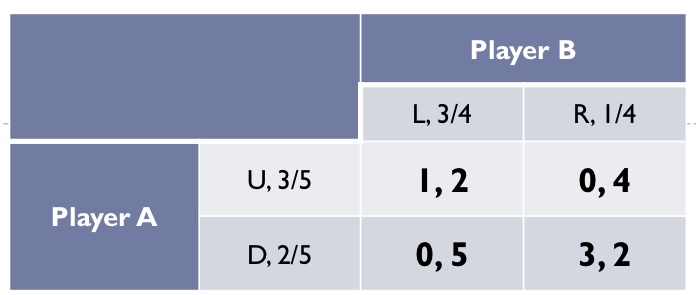L9: Game Theory II
1/23
There's no tags or description
Looks like no tags are added yet.
Name | Mastery | Learn | Test | Matching | Spaced |
|---|
No study sessions yet.
24 Terms
Sequential game
Players take turns in making choices
Previous choices are known to players - still compete information!
Game represented as a tree (also called extensive form)
Decision tree/extensive form
Each non-leaf node represents a decision point for some player
Non-terminal note: not an endpoint
Terminal node: indicates the game is over
Branches represents available choices/actions
We can change simultaneous games into sequential games
Utilities are known to both players —> means games are very strategic

Extensive form example
Player A goes first, player B reacts to A
Both Nash equilibria (3, 9) and (2, l) are still there
What does player A play?
You compare the best options on both sides of tree
Aka (3,9) and (2,1)
Which one is now likely to occur?
If A plays U: what would B do? L9>8
If A plays D: what would B do? R 1 > 0
What is the equilibrium?
(U,L) is Nash equilibrium - only one in sequential games
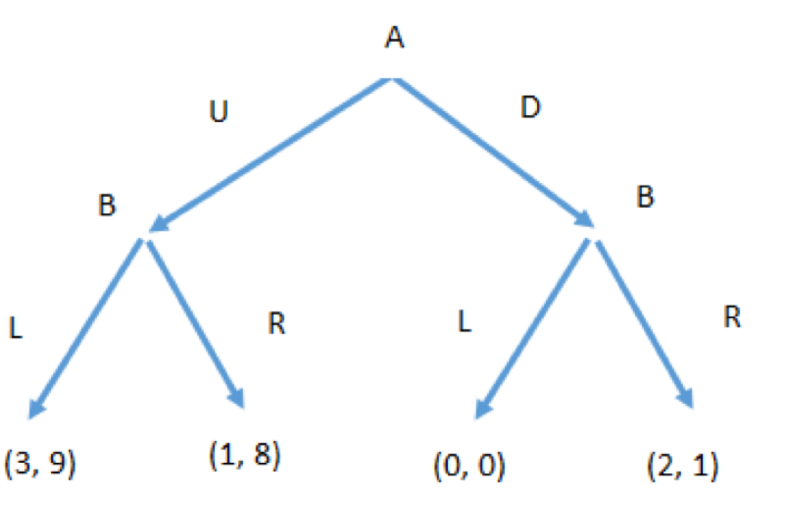
Subgame Perfect Equilibria
Not all Nash equilibria are sensible in extensive form games
Players maximize their rewards based off what they can still obtain, not what they could have obtained
Subgame perfect equilibrium refines the concept of nash equilibrium accordingly
Sub game: if we make the equilibrium, we have to make sure is credible (it is reasonable)
Need to chip tree down in different games
Perfect: by looking at the sub game, we ensure that the threat is credible
Equilibrium: no one has the incentive to change their moves
So, in sequential games we try to rule out threats which are not credible
How to find the subgame perfect equilibria
Chopping down the tree in different subgames
A profile of strategies in an extensive form game is a Subgame Perfect Nash equilibrium (SPNE) if it induces a Nash equilibrium in every subgame
Start with smaller circles and go bigger —> each little branch, then what is the best between the little branch, then what is the best for the whole tree
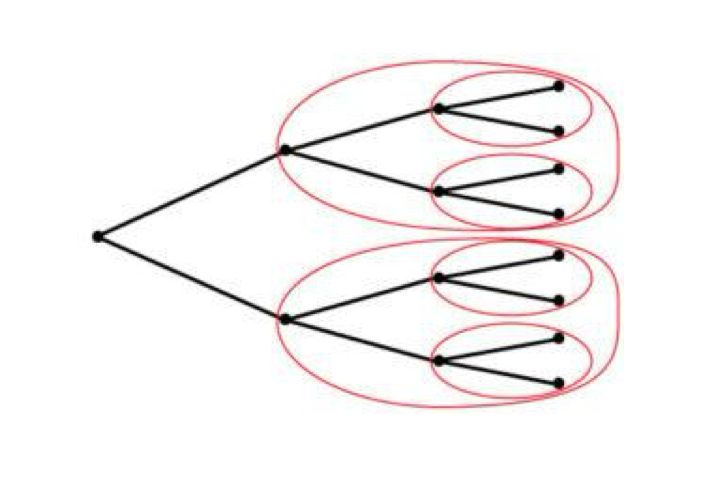
Escalation game background
Two states thinking about going to war with each other or not...
State I: accept the status quo or threatens
State 2: can responded concede or escalate the conflict
State I: can give up or go to war
To find equilibria: start at the end and move backwards
Backward induction

Escalation game equilibria
Back to the initial tree (minus some branches)
We know:
State I prefers war over give up
State 2 prefers to escalate over concede
All redundant branches are no longer in the picture
(-1, -1)
What is the best plan of action for State 1? Why?
State 1 → Accept: 0 > -1
What is the Subgame Perfect Equilibrium (SPE)?
(war accept, escalate) OR (war, accept)
War, accept notice of state 1 and (escalate) is choice of state 2
State 1 chooses to accept only bc they know that otherwise they know they will end up in war
*SPE Looks at the path to Nash equilibrium and what happens after
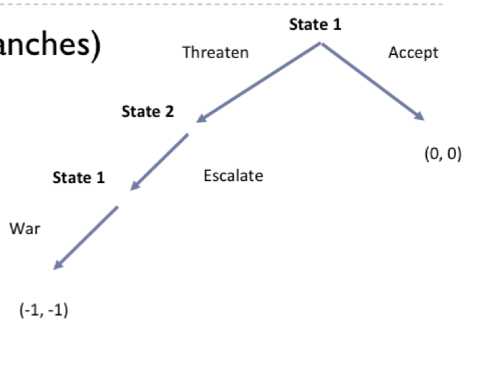
Subgame perfect equilibria: details
A subgame perfect equilibrium is a complete (!) and contingent plan of action
It must state what happens on and off the equilibrium path of the game
Just mentioning accept, does not tell us WHY state 1 accepts
It is only rational in connection to the moves and actions of the other state
Especially if you have this weird branch (longer than the other)
It is important to note that all subgame perfect equilibria are Nash equilibria
Since backward induction ensures that each player will play his or her best option at each node, the resulting strategies will correspond to a Nash equilibrium
In other words:A profile of strategies in an extensive form game is a Subgame Perfect Nash Equilibrium (SPNE) if it induces a Nash equilibrium in every subgame
Example: weird branch
C = weird branch —> think omg something happens (threat)
Green = NE of each sub game
Red = SPE
SPE = (C, H L)
Player 1 only play C in light of threat of H and L
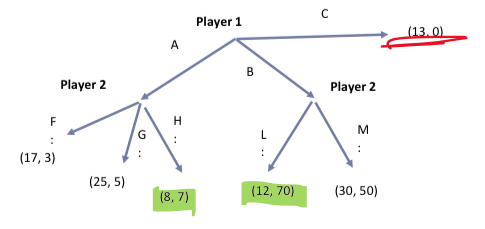
Mixed strategy Nash equilibria
exists in a strategic game, when the player does not choose one definite action, but rather, chooses according to a probability distribution over his actions
Pure vs mixed strategies
Pure = assigned 100% probability to only plan
Mixed = assigns probability to a particular action
Matching pennies example
Story:
You and your friend simultaneously reveal a penny
If both pennies show heads or both show tails, your friend must pay you
$1If one penny shows head and the other shows tail, you must pay your friend $1
What is the PSNE? There isn’t one

Matching pennies solution
The matching pennies game is a zero-sum game
No clear PSNE; there is always an incentives to change...
John Nash again contributed to the solution of these games:
If the game is finite (finite number of players and finite number of strategies) and there are no Pure Strategy Nash equilibrium, then there must be a Mixed Strategy Nash Equilibrium
It is possible to find a randomized mutual strategies that satisfy Nash Equilibrium requirements
Mixed strategies
a probability distribution over two or more pure strategies
If mixtures are mutual best response, the set of strategies is a mixed strategy Nash equilibrium
Assigns probability distribution over pure strategies
It is related to expected utility theory and lotteries
In MSNE, each player's probability distribution makes all other player's indifferent between their pure strategies (only true for 2 x 2 games)
Finding point where other player is indifferent to switching
That is, the utility of playing strategy I must equal the utility of playing strategy 2
Mixed strategy critique
Randomization, central in mixed strategies, lacks behavioural support: seldom do people make their choices following a lottery
How to calculate Mixed Strategy Nash Equilibrium (MSNE)
Find the probability of each outcome to occur in equilibrium
For each outcome, multiply the probability by a particular players payoff
Example mixed strategy
Two players {A,B}
4 actions: Up, Down, Left and Right
Are there any PSNE? No
Are there any MSNE?
If there is no PSNE there is for SURE a MSNE
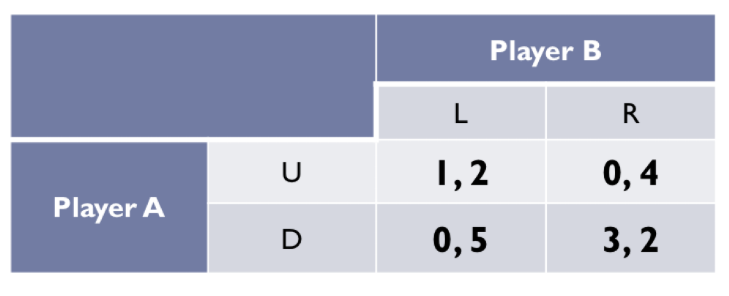
Step 0: player A
Instead of playing U or D, Player A selects a probability distribution (πu, l- πu), meaning that with a probability (πu) player A will play Up and with a probability (I - πu) will play Down
π = p (probability)
Player A is mixing over the pure strategies Up and Down
The probability distribution (πu, I- πu) is a mixed strategy for player A
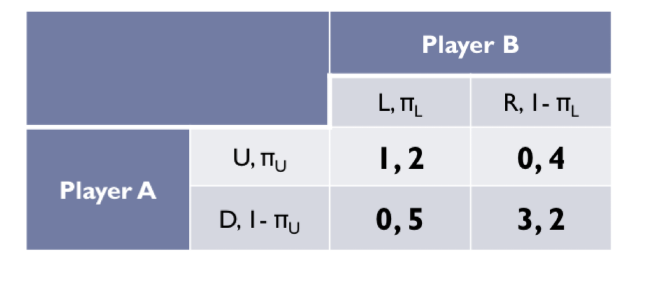
Step 0: player B
instead of playing L or R, Player B selects a probability distribution (πL, 1 - πL), meaning that with a probability (πL) Player B will play Left and with a probability (1 - πL) will play Right
Player B is mixing over the pure strategies Left and Right
The probability distribution (πL, 1 - πL) is a mixed strategy for Player B
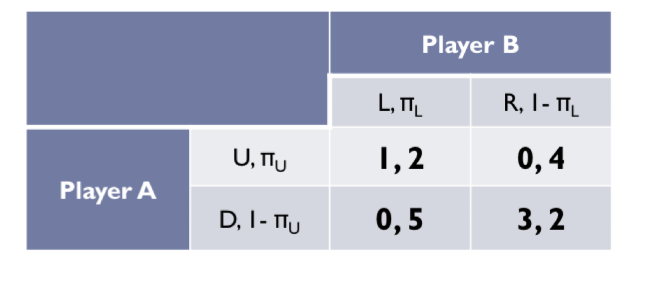
Step 1: solving for B
What is the utility of Player B for just going to the Left?
Utility of Player B depends on the probability of Player A to go Up/Down → Getting 2 or 5 in utility
If B plays left, her expected payoff is: 2pU + 5(1 - pU)
Utility X probability
What is the utility of Player B for just going to the Right?
Utility of Player 2 depends on the probability of Player A to go Up/Down → Getting 4 or 2 in utility
If B plays right, her expected payoff is: 4pU + 2(1 - pU)

Step 2: solving for B indifferent
For a mixed strategy for a player, we need to see some probability distribution that makes the other player indifferent between his or her pure strategies:
If 2πu + 5(1- πu) > 4πu + 2(1- πu), player B would play Left
If 2mu + 5(1-πu) < 4πu + 2(1 - πu), player B would play Right
So, for there to be an equilibrium, B must be indifferent between playing Left or Right i.e., we need to determine the threshold
2πu + 5(1-πu) = 4πu + 2(1 - πu)
Can you solve this?
2πy +5 - 5πu = 4πu +2-2πu
3πu+5=2πu+2
- 5πu= -3
πu = 3/5
Up
1 - πu = 2/5
Down
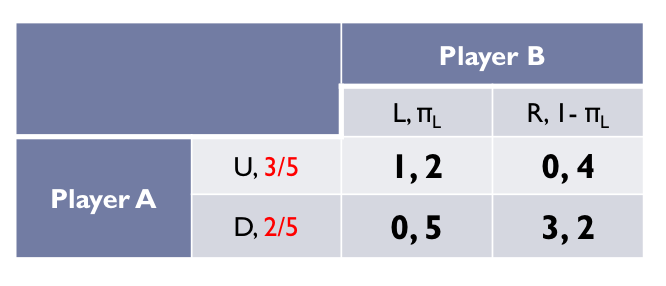
Step 3: solving for A
What is the utility of Player A for just playing Up?
Utility of Player A depends on the probability of Player B to go Left/Right
If A plays Up, his expected payoff is: 1πL+ 0(1-πl) = πL
What is the utility of Player A for just playing Down?
Utility of Player A depends on the probability of Player B to go Left/Right
If A plays Down, his expected payoff is : 0πL + 3(1-πL) = 3(1-πL)
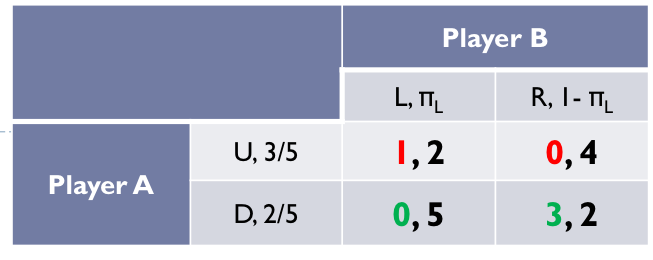
Step 4: solving for A indifferent
So, for there to be an equilibrium, A must be indifferent between playing Up or Down i.e., we need to determine the threshold
πL = 3(1-πL)
Can you solve this?
πL = 3 - 3πL
4πL = 3
πL =3,142 L 3/4
πL= 3/4
Left
1 - πL = 1/4
Right
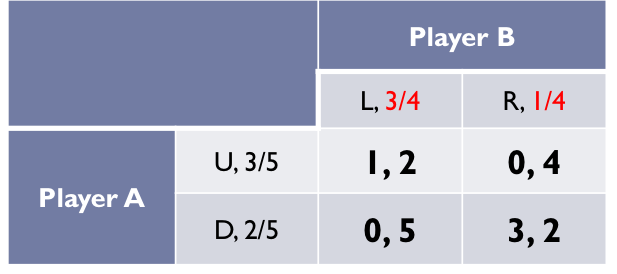
Step 5: MSNE
MSNE = (3/5, 2/5) (3/4, 1/4)
Alternative writing
MSNE = (3/5U, 3/4L)
MSNE = (3/5, 3/4)
NOTE: always write in fractions
